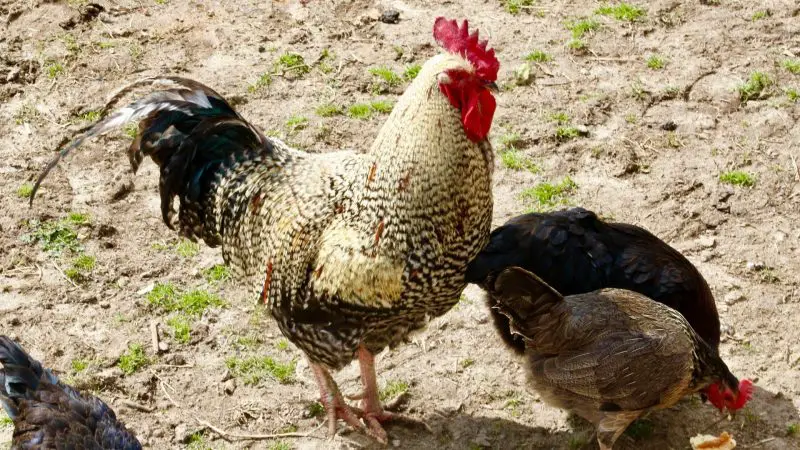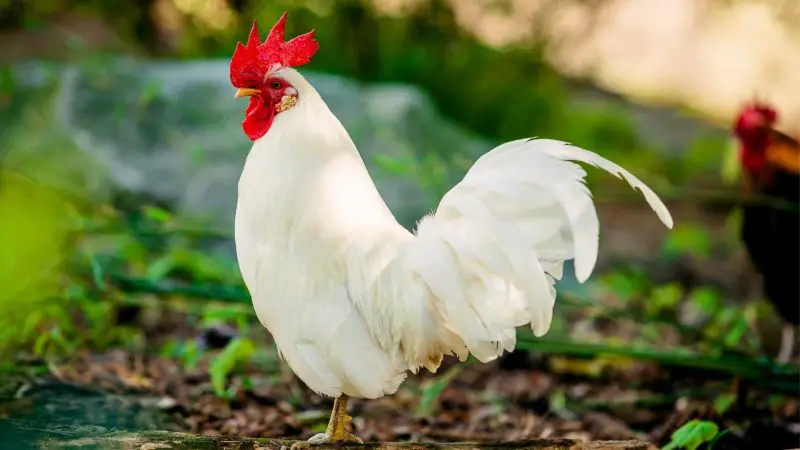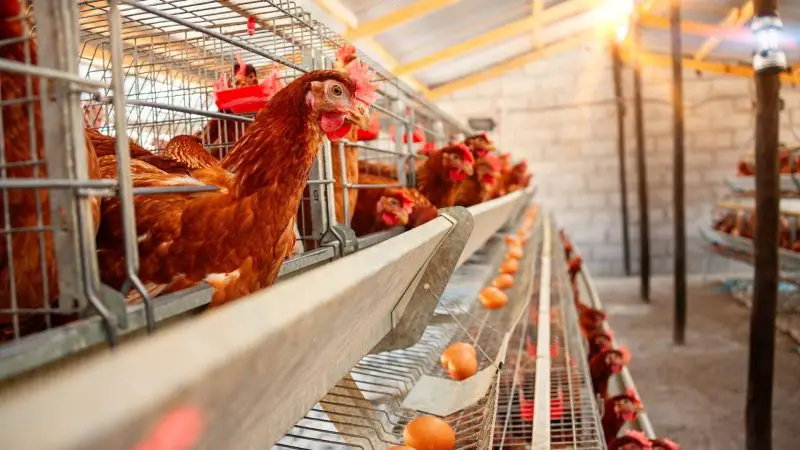If you are looking into acquiring chickens for eggs, you may wonder at one point if roosters are a good option. For starters, there are various rooster breeds, and all of them have one purpose—protect and mate with the hens.
Can roosters lay eggs? Rooster term refers to a mature male chicken. So, this means that roosters or cocks/cockerels can’t lay eggs since they don’t have the reproductive organ to do so. Only the hens or female chickens can lay eggs.
In this article, we’ll give you extensive information about roosters, such as their egg production, caring process, etc. So, if you are curious about roosters in general, consider taking the time to read this article to find out more about roosters.
Is a Rooster a Male Chicken?

Most people use the word hen when referring to chicken. However, a hen denotes a female chicken, while a rooster represents a male chicken.
A young male chicken is regarded as a cockerel before reaching one year of age. After a year, the male chicken will be deemed as a rooster.
Meanwhile, a young hen less than one year is called a pullet. Although these terminologies can be confusing at times, roosters and hens are both chickens.
Related: Is a Rooster a Chicken? | Information and Facts
What Do Roosters Do in the Flock?

Roosters are the savior of the flock. They alert their group when they sense danger is close and will fight anyone who will threaten the hens and eggs, be it a human or an animal.
They need to be in charge of their hens and territory, which often results in aggressive manners directed at caretakers.
They may resort to chasing you away from their flock, pecking at your ankles, and even using their spurs—the part of their shank’s bone wrapped with a tough layer used for defense and fighting.
How to Care For Your Roosters?

When you hear roosters crow, it is for a variety of reasons. This includes clashing with other chickens, spotting predators, or finding food.
To ensure that your roosters are well-cared:
- Keep their pen clean.
- Ensure they have plenty of water and food, even nighttime.
- Confine them to their coop all night to minimize distractions.
- Make sure that your yard is predator-proof to dodge nasty surprises.
- Make it a 1:8 ratio to evade squabbles. This means putting one rooster per 8 hens to avoid squabbles. Expanding the number of hens into 10 also works fine.
Egg Production | What You Need to Know

Hens can deliver only one egg per day, and some days, they won’t lay an egg at all. The causes for this laying timetable link to the hen’s reproductive system.
Hens body starts forming an egg shortly after the previous egg delivery and takes 26 hours to develop fully. Since hens’ reproductive systems are vulnerable when exposed to light, they will lay too late in the day and start forming new eggs. They will then miss a day or more before laying eggs again.
Moreover, hens in a flock do not start to lay on precisely the same day nor continue delivering eggs at the same time length. The time length of producing eggs differs as well for the flock.
Chicken flocks deliver eggs on and off for approximately three to four years. Each year, egg level production is much lower than the previous year.
Furthermore, the egg size increases per year, but the quality of the shell reduces. Both the egg numbers and the year count a flock will produce eggs rely on several factors, such as:
- Breed
- Light management
- Management of pullets prior to lay
- Nutrition
- Space allowances
Breed
Some commercial chicken breeds have been specifically developed for egg production. For instance, the commercial White Leghorn is raised for large egg production complexes but typically doesn’t produce well in home flocks.
The eggs they lay are white-shelled, not brown-shelled. Moreover, many dual-purpose chicken breeds, like the Rhode Island Reds and Plymouth Rocks lay eggs with light brown colored shells.
Meanwhile, Maran hens deliver eggs with dark, chocolate-colored shells, while the South American breed—Araucana lays eggs with light blue shells. By crossing Araucanas with other chicken breeds, breeders have developed Easter Eggers—hens that delivered eggs with green, light blue, or pink shells.
When deciding on which breed or breeds to grow, keep in mind that the commercial hens may present you with a higher egg production level initially. However, other breeds tend to lay for more years, like the Australorp hen, which holds the world record for egg production with 364 eggs for 365 days.
Pullet Management
It is crucial to handle pullets accurately, particularly in the areas of light management and nutrition. This is because correct handling or management affects the quality and level of egg production once the hens begin to lay.
If the pullets arrive into production too early, they might encounter problems with prolapse, resulting to:
- Lack of appetite
- Self-isolation
- Unwillingness to eat and socialize
- Puffing out feathers
- Lethargy and lack of energy
In addition, the hens may deliver more undersized eggs throughout the production process. For future laying chicken flocks, bear in mind that light management is critical from brooding through entire laying periods.
If you buy ready-to-lay pullets, it is essential to ask how the pullets were grown concerning light management and nutrition so you can modify your succeeding flock management accordingly.
For instance, delaying light stimulation when hens are too small.
Light Management (Year-Round Production)
Chickens are dubbed as long-season breeders, which means they begin delivering eggs when light hours are more per day. Generally, a day-old chick is preserved on 23 to 24 hours of light each day for the first few days, ensuring they can come upon food and water.
After that duration, reduce the number of hours of light per day to at least 8 hours. When pullets or young hens are ready to start laying, lift the light exposure gradually until they are exposed to 14 to hours of light each day.
This exposure helped encourage the flock to lay. To maintain the chicken flock lay all year round, keep at least 14 hours of light per day as a timetable.
You can expand the light amount gradually to 16 hours each day during in late egg production cycle, helping uphold the flock in production. For the flock owners, this approach involves supplying additional lighting.
Using a lamp with a stop/start timer can push the light to operate at dawn and during the evening before sunset, ensuring the suitable light length exposure for a total of 14 to 16 hours.
You can also get a light sensor so that the lamp won’t come on when natural daylight is present. By using this, you minimize the use of your electricity.
The additional light you equip does not have to be excessively bright— a standard 60-watt incandescent bulb functions just fine for a small laying chicken flock.
Nutrition
Any chicken type at any age requires a balanced diet. Feed mills produce ingredients in mixtures, providing the needed nutrients of a flock in one whole package.
Some producers blend whole feeds with more affordable scratch grains. However, doing so dilutes the nutrient levels the chickens are getting, resulting in nutrient deficiencies.
This can adversely impact the pullets’ growth and the production level of hens. It is also essential to a particular feed made for the chicken age and type.
For instance, do not provide a meat-maker diet type to developing pullets or laying hens since it will not satisfy their nutritional necessities. Likewise, do not feed growing chickens with a layer diet.
The laying hen’s diet is high in calcium, required for eggshells production. This calcium level, however, is detrimental to non-laying chickens.
Space Allowances
To produce more eggs, the laying hens must have a bigger space. The floor space size required by the flock relies on the chicken size and the housing type used.
In general, the space allowance used is a minimum of 1.5 sq. feet for each hen or up to 2 sq. feet per hen. It is best to note that larger breeds will require larger space allowances.
To maximize the use of the whole housing facility, you can integrate perches. Hens love to sleep on the perches at dusk, keeping them off the coop floor.
The usage of perches also allows manure concentration in a single site, making poultry house cleaning more manageable.
Frequently Asked Questions
What Is the Dissimilarity Between a Chicken and a Rooster?
The word chicken is a general term for rooster and hen breeds. A rooster refers to a male chicken, while the hen denotes a female chicken.
When you hear the word cockerel, it is a young rooster less than one year of age, and the term pullet refers to a young hen lesser than a year of age.
What Is the Purpose of Roosters When Hens Can Deliver Eggs Without Any Assistance?
Since roosters can’t produce eggs, you may wonder about the significance of keeping one for your hens. The answer to this is simple—although hens can deliver eggs, they won’t hatch into chicks without a rooster. If mating does not transpire, the eggs won’t be fertilized.
How Long Is the Egg Laying Process of Hens?
The egg-laying process takes between 24 to 26 hours, with most of the essential formation occurring overnight. The eggshell creation makes up the longest part of egg formation, taking 20 hours out of that 26 hours.
Is It Ok to Eat Chickens First Eggs?
A hen’s first eggs are safe to eat but are lacking egg yolk. They are also typically smaller and periodically have an odd shape but are as healthy as the succeeding eggs.
Do Roosters Kill Hens?
Under certain conditions, roosters kill hens. Whether they do this on purpose or not, roosters killing hens occur in chicken flocks in every place.
What Are Roosters For?
Roosters are the guardians of the flock. They keep them safe by alerting the group when a predator comes.
On top of that, roosters also fertilize the hens’ eggs, allowing them to develop into baby chicks and defend the flock boldly against any attacker.
Why Do Roosters Not Lay Eggs?
Roosters are unable to lay eggs because they don’t possess the reproductive system of hens. Since they are males, their work is to fertilize hens’ eggs and protect the flock.
Related: Can Chickens Lay Eggs Without a Rooster? | All You Need to Know!
Are Hens Happier with Roosters?
Hens are not exactly happier with roosters. Chickens do squabbles sometimes and distress those in the lower pecking order. Nonetheless, keeping a rooster around appears to preserve harmony within the flock.
Hens also need roosters for egg fertilization, which is basically helping the hen’s eggs to hatch into baby chicks. But, if you don’t plan to fertilize the eggs, it would be fine not to have a rooster in a flock.
Is It Required to Keep a Rooster in the Flock?
Roosters are not always welcome in a coop, but they have their benefits. However, it is not mandatory to have a rooster among the flock.
What Is a Fart Egg?
A fart egg is an undersized egg laid by a hen. It is much smaller than normal eggs and generally does not contain a yolk.
This often occurs in the early stages of a hen’s reproductive process.
Summary
The chicken reproduction process is an intriguing one. Although roosters can’t deliver eggs, this doesn’t imply they don’t have a purpose.
In fact, roosters have a crucial role in fertilizing the hen’s eggs. Without them, the eggs won’t be hatched into baby chicks.
List of Sources
Poultry Breeds – Australorp Chickens
Raising Layer Chicks and Pullets
Effects of Pullet-Stocking Density on Performance of Laying Hens
